Menno Simons
Menno Simons (1496 – 31 January 1561) was a Roman Catholic priest from the Friesland region of the Low Countries who became an influential Anabaptist religious leader. Simons was a contemporary of the Protestant Reformers and it is from his name that his followers became known as Mennonites.
Menno Simons | |
|---|---|
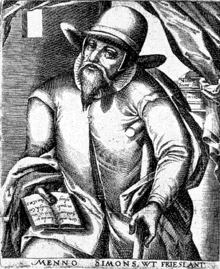 "Menno Simons from Friesland" 1608 engraving by Christoffel van Sichem | |
| Church | Mennonites |
| Personal details | |
| Born | 1496 Witmarsum, Friesland, Holy Roman Empire |
| Died | 31 January 1561 Wüstenfelde, Duchy of Holstein, Holy Roman Empire |
| Buried | Bad Oldesloe |
| Denomination | Roman Catholic (until 1536), Anabaptist (from 1536) |
| Spouse | Geertruydt Jansdochter |
| Children | Two daughters, one son |
| Profession | Catholic priest (until 1536), Anabaptist minister and author (from 1536) |
"Menno Simons" (/ˈmɛnoː ˈsimɔns/) is the Dutch version of his name; the Frisian version is Minne Simens (/ˈmɪnə ˈsimn̩s/),[1] the possessive "s" creating a patronym meaning "Minne, son of Simen" (cf. English family names like Williams and Rogers).
Biography
Early life
Menno Simons was born in 1496[2] in Witmarsum, Friesland, Holy Roman Empire. Very little is known concerning his childhood and family except that he grew up in a poor peasant environment. His father's name was Simon, Simons being a patronym, and he had a brother named Pieter.[3]
Simons grew up in a disillusioned war-torn country. Friesland was ravaged by war in the late 15th and early 16th centuries. Landsknecht soldiers haunted the Frisian lands in the 1490s to force the 'Free' Frisians to accept the Duke of Saxony-Meissen as their head of state. The duke was the governor of the Netherlands for the Habsburg family. One of the archenemies of the Habsburgs, the Duke of Guelders, invaded Friesland in 1515 and conquered half of it. Saxony ceded the other half to the Habsburgs. The Frisians tried to regain their freedom but they were too weak and eventually accepted the imperial authority of the Habsburg emperor Charles V.
Simons learned Latin and some Greek, and he was taught about the Latin Church Fathers during his training to become a priest.[3] He had never read the Bible, either before or during his training for the priesthood, out of fear that he would be adversely influenced by it. When he later reflected upon this period in his life, he called himself stupid.[4]
Roman Catholic Church
He was ordained as a Roman Catholic priest in 1515 or 1516[5] in Utrecht. He was then appointed chaplain in his father's village Pingjum (1524).
Around 1526 or 1527, questions surrounding the doctrine of transubstantiation caused Menno Simons to begin a serious and in-depth search of the Holy Scriptures, which he confessed he had not previously studied, even being a priest. At this time he arrived at what some have termed an "evangelical humanist" position.
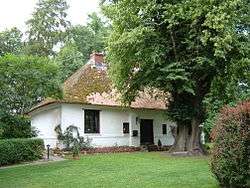
Menno's first knowledge of the concept of "rebaptism", which he said "sounded very strange to me", came in 1531 after hearing of the beheading of Sicke Freerks Snijder at Leeuwarden for being "rebaptized" ("Snijder", meaning "tailor", was probably not the family name, since Freerks is the patronym form of Freerk and Sicke was, in fact, a tailor by trade). A renewed search of the scriptures left Menno Simons believing that infant baptism is not in the Bible. He discussed the issue with his pastor, searched the Church Fathers, and read the works of Martin Luther and Heinrich Bullinger. While still pondering the issue, he was transferred to Witmarsum. Here he came into direct contact with Anabaptists, preaching and practicing "believer's baptism". Later, some of the Münsterite disciples came there as well. While he regarded them as misled and fanatical, he was drawn to their zeal and their views of the Bible, the Church, and discipleship.
In 1535, his brother Pieter was among a group of Anabaptists killed near Bolsward because of his participation in the violent takeover of a Catholic monastery known as the Oldeklooster (or Bloemkamp Abbey). This monastery, near Bolsward in the Dutch province of Friesland, was seized on 30 March 1535 by about 300 Anabaptists of Friesland, both men and women, led by Jan van Geelen, an emissary of the Anabaptists of Münster. They thereby won a strong position and from here tried to conquer the entire province. The imperial stadholder Georg Schenck van Toutenburg was put in charge of capturing the old monastery from the Anabaptists. He supposed that he would be able to do so easily, but found himself compelled to conduct a regular siege. On 1 April he decided to bombard the monastery with heavy artillery and tried to storm it. Four times he had to lead his soldiers into the fire. On the third assault they succeeded in taking several positions. Some of the fortifications and the church remained in Anabaptist possession. On 7 April the monastery was finally stormed after a severe battle. 300 Anabaptists were killed. Of the ones who did not lose their lives in the storming, 37 were at once beheaded and 132, both men and women, taken to Leeuwarden, where 55 were executed there after a short trial. Jan van Geelen escaped.
After the death of his brother Pieter, Menno experienced a spiritual and mental crisis. He said he "prayed to God with sighs and tears that He would give to me, a sorrowing sinner, the gift of His grace, create within me a clean heart, and graciously through the merits of the crimson blood of Christ, He would graciously forgive my unclean walk and unprofitable life..."[6]
Anabaptists
| Part of a series on the |
| Reformation |
|---|
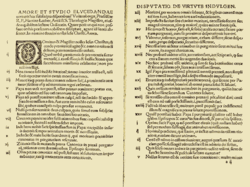 |
|
Contributing factors |
|
Theologies of seminal figures |
|
|
By location |
|
Major political leaders |
|
Counter-Reformation |
|
Art and literature Painting and sculpture
Building Literature Theater |
|
Music Forms
Liturgies
Hymnals
Secular Music |
|
Conclusion and commemorations Conclusion
Monuments Calendrical commemoration |
| Protestantism |
Menno Simons rejected the Catholic Church and the priesthood on 12 January 1536,[5] casting his lot with the Anabaptists. The exact date of his new baptism is unknown, but he was probably baptized not long after leaving Witmarsum in early 1536. By October 1536 his connection with Anabaptism was well known, because it was in that month that Herman and Gerrit Jans were arrested and charged with having lodged Simons. He was ordained around 1537 by Obbe Philips. Obbe and his brother, Dirk Philips, were among the peaceful disciples of Melchior Hoffman (the more radical of Hoffman's followers having participated in the Münster Rebellion). It was Hoffman who introduced the first self-sustaining Anabaptist congregation in the Netherlands, when he taught and practiced believers' baptism in Emden in East Frisia. Menno Simons rejected the violence advocated by the Münster movement, believing it was not Scriptural.[7] His theology was focused on separation from this world, and baptism by repentance symbolized this.[7]
For true evangelical faith is of such a nature that it cannot lie dormant; but manifests itself in all righteousness and works of love; it dies unto flesh and blood; destroys all forbidden lusts and desires; cordially seeks, serves and fears God; clothes the naked; feeds the hungry; consoles the afflicted; shelters the miserable; aids and consoles all the oppressed; returns good for evil; serves those that injure it; prays for those that persecute it; teaches, admonishes and reproves with the Word of the Lord; seeks that which is lost; binds up that which is wounded; heals that which is diseased and saves that which is sound. The persecution, suffering and anxiety which befalls it for the sake of the truth of the Lord, is to it a glorious joy and consolation.
— Menno Simons, Why I Do Not Cease Teaching and Writing, 1539
Menno evidently rose quickly to become a man of influence. Before 1540, David Joris, an Anabaptist of the "inspirationist" variety, had been the most influential leader in the Netherlands. By 1544, the term Mennonite or Mennist was used in a letter to refer to the Dutch Anabaptists.
Twenty-five years after his renunciation of Catholicism, Menno died on 31 January 1561 at Wüstenfelde, Holstein, and was buried in his garden.[3] He was married to a woman named Gertrude, and they had at least three children, two daughters and a son.[8]
Theology
| Part of a series on |
| Anabaptism |
|---|
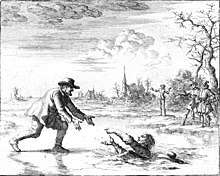 Dirk Willems (picture) saves his pursuer. This act of mercy led to his recapture, after which he was burned at the stake near Asperen (etching from Jan Luyken in the 1685 edition of Martyrs Mirror) |
|
Background |
|
Distinctive doctrines |
|
Largest groups |
|
Related movements |
|
|
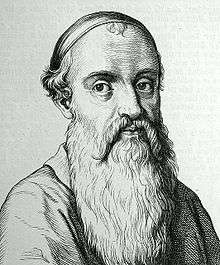
Menno Simons' influence on Anabaptism in the Low Countries was so great that Baptist historian William Estep suggested that their history be divided into three periods: "before Menno, under Menno, and after Menno". Menno is especially significant because of his coming to the Anabaptist movement in the north in its most troublesome days, and helping not only to sustain it, but also to establish it as a viable Radical Reformation movement.
Excommunication
Girolimon (1995) compares the teachings of Menno Simons with those of Protestant reformer John Calvin (1509–64), focusing on the issue of excommunication. This theological analysis stresses sharp contrasts between the two leaders on four basic principles: on procedures leading to excommunication, on the severity of sanctions on the excommunicant, on the restoration of a repentant individual, and on civil punishment. Calvin and Menno, each a leader of distinct wings of the Reformation, both believed this extreme form of discipline to be essential to the function of the church in society, agreeing on the basic grounds for excommunication as expressed in the New Testament. Menno, however, envisioned the application of reprimand as a process administered by the entire church body against any sin; Calvin reserved excommunication for especially severe transgressions as identified by the Company of Pastors and the Consistory. Among other disagreements, Calvin approved civil punishment for certain forms of unorthodoxy while Menno advocated strict church/state separation. They differed most profoundly in their views on why church discipline was necessary. Simons saw human perfectability as attainable after conversion, while Calvin stressed an Augustinian theology of human depravity.[9][10]
Bride of Christ
Menno Simons drew heavily from Biblical images of the bride of Christ when envisioning a new church. He found in the Biblical Song of Solomon a description of the relationship between a purified church and Christ that not only applied to a reformed church but also to the earthly marriage between man and woman. Like the bride in the songs, the woman must come in total love and devotion and will be cleansed of her natural evil by contact with her husband. He did not alter the conventional view of relations between men and women but idealized the woman's subordinate and asexual status.[11]
Infant baptism
The Anabaptists insisted on adult baptism. By contrast, Martin Luther defended infant baptism; his belief in it stemmed from his view of the church as ideally an inclusive reality in a Christian society. Menno Simons based his rejection of infant baptism on the concept of the church as a disciplined group of individuals who have voluntarily committed their lives to Christ. He viewed sanctification as a lifelong process that does not completely rid the presence of sin from one's life.[12]
Peace
Although some Anabaptists in Amsterdam and Münster in the 16th century engaged in violence and murder, Dutch Mennonites generally became pious and peaceful. In his 1539 Christian Baptism Menno Simons stated his reluctance to engage in disputes, which may have stemmed from his reluctance for years to announce his true convictions.[13] Simons' relationships with the radical Münsterites and peaceful Melchiorites may offer additional clues.
Asceticism
Menno Simons rejected asceticism in terms of its traditional practices of social withdrawal, mortification, and self-denial. Historical theologian Richard Valantasis, however, has suggested that asceticism should not be defined as these physical practices but as a group of activities designed to re-establish social relations between the individual and the dominant social environment through a new subjectivity, different social relations, and an alternative symbolic universe. Simons' theology is ascetic by Valantasis's definition since it used these methods to restructure Anabaptists' relationship with 'worldly' society.[14]
Works
- Van de Geestlijke Verrijsenisse (ca. 1536; The Spiritual Resurrection)
- De nieuwe Creatuere (ca. 1537; The New Birth)
- Christelycke leringhen op den 25. Psalm (ca. 1538; Meditation on the Twenty-Fifth Psalm)
- Why I Do Not Cease Teaching and Writing (1539)
- Dat Fundament des Christelycken leers (1539–40; Foundation of Christian Doctrine)[15]
Notes
- Hendrik Twerda, Fan Fryslâns Forline, Bolsward, 1968 (Utjowerij A.J. Osinga), p. 128.
- Menno's life. Menno Simons.net. Retrieved on 15 April 2009.
- Menno Simons (1496-1561). Global Anabaptist Mennonite Encyclopedia Online. Retrieved on 20 April 2009.
- (in Dutch) Menno Simons' uitgang uit het Pausdom.. Digital library for Dutch literature. Retrieved on 20 April 2009.
- Herbermann, Charles, ed. (1913). . Catholic Encyclopedia. New York: Robert Appleton Company.
- "Menno Simon's Renunciation of the Church of Rome". Archived from the original on 19 May 2007. Retrieved 13 April 2007.
- Gonzalez, J. (1975). A History of Christian Thought. Abingdon Press. p. 96.
- Geertruydt (16th century). Global Anabaptist Mennonite Encyclopedia Online. Retrieved on 26 October 2012.
- Michael Thomas Girolimon, "John Calvin and Menno Simons on Religious Discipline: A Difference in Degree and Kind," Fides et Historia 1995 27(1): 5-29
- Charles Wiley, "'Hand this Man over to Satan': A Comparison of John Calvin and Menno Simons on Excommunication," Fides et Historia 1993 25(3): 16-32
- Beth Kreitzer, "Menno Simons and the Bride of Christ," Mennonite Quarterly Review 1996 70(3): 299-318
- Egil Grislis, "Martin Luther and Menno Simons on Infant Baptism," Journal of Mennonite Studies 1994 12: 7-25
- Abraham Friesen, "Present at the Inception: Menno Simons and the Beginnings of Dutch Anabaptism," Mennonite Quarterly Review 1998 72(3): 351–388
- Lawrence J. Altepeter, "The Asceticism of Menno Simons," Mennonite Quarterly Review 1998 72(1): 69-83
- Menno's Foundation-Book. Menno Simons.net. Retrieved on 15 April 2009.
References
- Dutch Anabaptism: Origin, Spread, Life and Thought (1450–1600), by Cornelius Krahn
- The Anabaptist Story: An Introduction to Sixteenth-Century Anabaptism, by William Roscoe Estep ISBN 0-8028-0886-7
- The Complete Writings of Menno Simons..., translated by Leonard Verduin and edited by John C. Wenger, with a biography by Harold S. Bender ISBN 0-8361-1353-5
External links
- Menno Simons in Global Anabaptist Mennonite Encyclopedia Online
- Prints Bibliotheca Mennonitica Amsterdam: Doopsgezinde prenten
- Menno Simons. Life, writings, images and links
- Menno Simons Biography from the Church of the Brethren.net
- Dr Victor Shepherd (2001). "Chapter 10: Menno Simons (1496 - 1561)". Witnesses to the Word. Toronto: Clements Pub. ISBN 1-894667-00-X. Archived from the original on 5 February 2007.
- A Foundation and Plain Instruction of the Saving Doctrine of Our Lord Jesus Christ